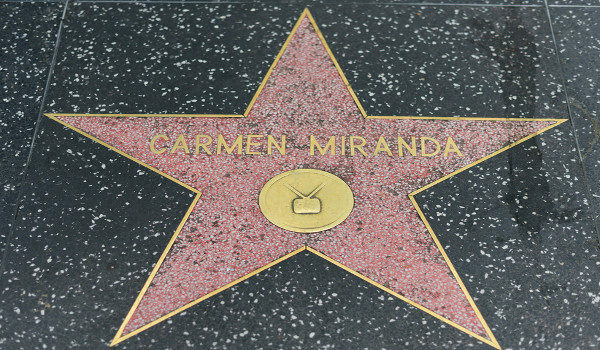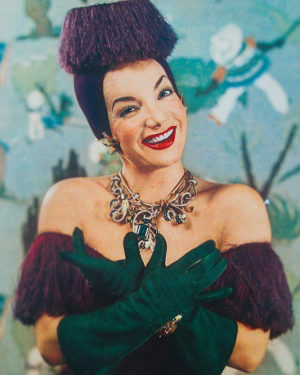Maria do Carmo Miranda da Cunha, artistically known as Carmen Miranda (Canaveses, Portugal, February 9, 1909 - Los Angeles, United States, August 5, 1955) was a Portuguese-Brazilian singer, actress and dancer. With international fame, Carmen Miranda was called “A Pequena Remarkable” and “Brazilian Bombshell” sexy or attractive).
Carmen Miranda, Portuguese by birth and Brazilian by upbringing, was the first woman to sign a contract with a radio station in Brazil. With her unique style and talent for music and acting, she has conquered other countries, she has settled in the States United and became the highest paid woman in Hollywood, in addition to being the first South American with a star at Hall of Fame.
Childhood and Adolescence
Carmen Miranda was born on February 9, 1909, in Canaveses, Portugal. Daughter of José Maria Pinto da Cunha, a barber, and Maria Emília Miranda, she came to Brazil at less than a year old.
As a teenager, Carmen Miranda worked in a hat shop. Living with the hectic life of Lapa, a neighborhood in Rio de Janeiro, brought the teenager closer to music and also influenced her future aesthetic references. In 1929, Carmen was introduced to composer Josué de Barros, a professional who introduced her to theaters and clubs.
Do not stop now... There's more after the advertising ;)
Career
From 1930 onwards, Carmen Miranda entered the music world, singing at Rádio Sociedade. Soon her album was released, and her success came with the song march for you to like me, More known as there, written by Joubert de Carvalho.
Her career began to take on new air at the same time, when the singer made her first tour in Argentina, a country to which she returned several times in the following years. Upon joining Rádio Mayrink Veiga, Carmen Miranda became the first woman to sign a contract with a Brazilian radio station.

Carmen Miranda star on the Walk of Fame in Hollywood. (Image credit: Hayk_Shalunts/Shutterstock.com)
In 1936, Carmen Miranda won the big screen with hello hello carnival, film that provided the singer with the duet with her sister, Aurora Miranda, in the well-known music scene Radio singers. In the same year, Carmen became part of Cassino da Urca, a place that served as a passport to an international career in musicals.
Bahian costume
The image widely linked to Carmen Miranda is her Bahian costume. The clothing was adopted by the singer and actress in 1939, when she participated in the film banana of the land, feature film in which Carmen performed one of her main musical performances with what does the baiana have, by Dorival Caymmi.
The Bahian costume adopted by Carmen Miranda underwent variations throughout her career, but always featured earrings large (usually hoops) and a turban full of fruit and flowers, platform shoes and sandals, and clothing with ruffles. The clothing was very successful around the world and started to be used as a costume at different parties, such as the Carnival.
The Little Remarkable
Carmen was a woman considered to be of short stature, measuring 1.52 m tall, but who drew attention for her interpretation and her characterization, which earned her the nickname of “the Little Remarkable”.
Main songs by Carmen Miranda
For you to like me (Taí)(Joubert de Carvalho)
swing (Braguinha/Alberto Ribeiro)
what does the baiana have(Dorival Caymmi)
Mom I want(Vicente Paiva and Jararaca)
Striped shirt(Assis Brave)
Tico-tico in cornmeal(Miguel Lima/Zequinha de Abreu)
on baiana's board(Ary Barroso)
goodbye drumming(Synval Silva)
the tick of my heart(Alcyr Red Pires/Walfrido Silva)
mutt dog(Alberto Ribeiro)
bullfights in Madrid(Braguinha/Alberto Ribeiro)
And the world is not over(Assis Brave)
how are you (Ary Barroso)
When I think of Bahia(Ary Barroso)
chica chica boom chic (Gordon Mack and Warren Harry) - Movie Music one night in Rio
Good Neighbor Policy
In the mid-1930s, the United States sought closer ties with Latin American countries as a way to prevent these countries from allying themselves with German troops. With Brazil, the US government used art and industrial financing to gain the sympathy of the Brazilian people and local authorities.

On the rise in the US, Carmen Miranda saw her fame grow during this period and became the closest link culture of Brazil with the United States, representing Brazilian music in the territory North American.
The Little Remarkable had its figure directly linked to the so-called “Good Neighbor Policy”, a factor that generated distrust in a portion of the population and remains under discussion, including among academic, about its influence on the “Americanization” of Brazil and responsibility for the diffusion of the stereotype gives "banana republic”.
See too: Brazil in World War II
Carmen Miranda's Top Films
The Sung Carnival of 1932(1932)
the voice of carnival (1933)
hello hello Brazil (1935)
students(1935)
hello hello carnival(1936)
banana of the land(1939)
China orange (1940)
tropical serenade (1940)
one night in Rio(1941)
It happened in Havana(1941)
my brazilian secretary(1942)
Between the blonde and the brunette(1943)
four girls in a jeep(1944)
bohemian serenade(1944)
Joy, boys!(1944)
star dreams(1945)
if i were happy(1946)
Copacabana(1947)
the prince charming(1948)
Romance carioca(1950)
scared to death(1953)
Carmen Miranda interprets the song chica chica boom chic in the movie one night in Rio (1941).
troubled marriage
Carmen Miranda married the American David Sebastian in 1947. David worked for a film production company and became Carmen's manager after their marriage.
Biographers point to David as an influence on Carmen Miranda's dependence on alcohol, as the singer began to drink to excess during her troubled marriage to her alcoholic husband. Due to her routine of professional commitments, Carmen also started to use barbiturates (medicines for insomnia).
addiction and death
Addicted to alcohol and medicine, Carmen Miranda returned to Brazil for a period of detoxification, in 1954. The following year, Little Remarkable returned to the United States with symptoms better but still dependent on medication.
On August 4, 1955, Carmen Miranda gave her last performance, a recording of The Jimmy Durante Show, followed by a party at her house.
Carmen Miranda died at dawn on August 5, 1955, aged 46, victim of a heart attack, at her home in Beverlly Hills (Los Angeles, USA). The singer was veiledthe one in California and later transported to Rio de Janeiro to say goodbye to fans, friends and family, being buried in the São João Batista Cemetery.
Tribute
In 1960, a sculpture in honor of Carmen Miranda was created to be exhibited at Largo da Carioca, in Rio de Janeiro. Currently, the work is displayed on the street named after the artist, on Ilha do Governador.

Bust in honor of Carmen Miranda portrays the actress in a Bahian costume. (Credit: SantaRosa OLD SKOOL | Wikimedia Commons)
By Lorraine Vilela
Journalist
